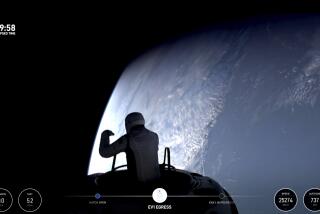Spacewalk Is Cut Short by Extreme Cold
- Share via
HOUSTON — Two spacewalking astronauts got a chilly reception in the void beyond their spaceship Thursday, exposing their fingers and toes to such cold that ground controllers decided to cut short their planned work agenda.
“Sounds like we put you in the deep freeze today,” space shuttle Discovery pilot Eileen M. Collins told the spacewalkers toward the end of a deliberate chill-out designed to evaluate recent modifications in the $10-million spacesuits. She was assisting them with checklists by radio from inside the shuttle.
“It was like putting my fingers in the liquid nitrogen freezer,” responded spacewalker Michael Foale. NASA officials said the experiment showed they will have to further modify the suits’ thermal controls.
Shortly after they began their 4 1/2-hour spacewalk just before 4 a.m. PST, Foale and Dr. Bernard Harris Jr., the first black astronaut to take a spacewalk, rode the shuttle’s 50-foot remote-control arm out of the cargo bay and into the harsh environment some 35 feet out from the ship.
Their goal was to approximate the working conditions that will greet space-faring workers attempting to construct an international space station in orbit, beginning in 1997. NASA spacewalk training specialist Gerald Miller said temperatures at the orbital construction site will actually be “somewhat colder.”
Even when the shuttle is on Earth’s nightside, he noted, the cavity of its open payload bay retains radiated heat. By contrast, space station crews will be working in the open, sometimes blocked from sunlight.
For the spacewalk, the shuttle was oriented deliberately to give the spacewalkers and all their equipment a “cold soak.” It flew with its belly toward the sun, shading the two astronauts and everything around them.
In an interview earlier, Foale had estimated the outside of the suit might get close to minus 135 degrees Fahrenheit. (The shuttle generally is prepared for extremes ranging from minus 200 to plus 200 degrees, officials said.)
More to Read
Sign up for Essential California
The most important California stories and recommendations in your inbox every morning.
You may occasionally receive promotional content from the Los Angeles Times.













